

Leong San Tong Khoo Kongsi 龍山堂邱公司
 Go Back - Latest PENANG Sights/Streets/New Properties > Malaysia > World | Hokkien : Lessons : Dictionary | YouTube | Facebook | About Me : Contact Me
Go Back - Latest PENANG Sights/Streets/New Properties > Malaysia > World | Hokkien : Lessons : Dictionary | YouTube | Facebook | About Me : Contact Me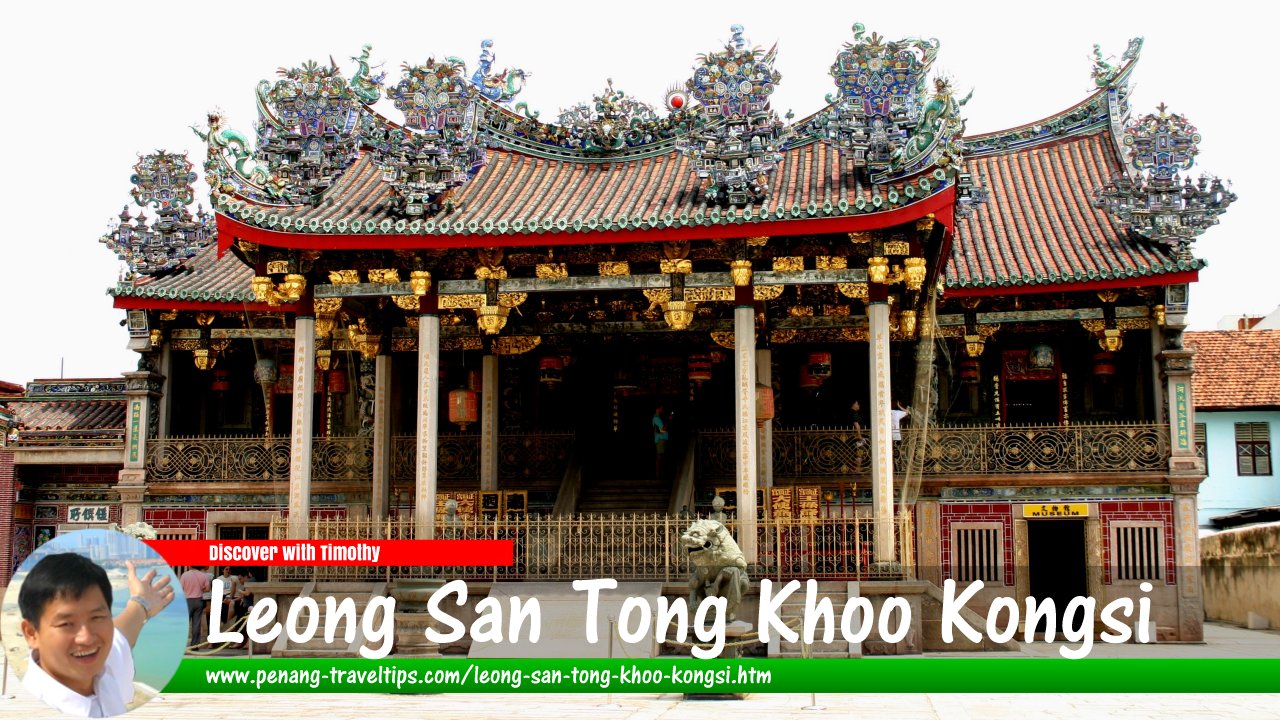 Leong San Tong Khoo Kongsi (28 February 2004)
Leong San Tong Khoo Kongsi (28 February 2004)
Leong San Tong Khoo Kongsi (GPS: 5.41433, 100.33756; Traditional Chinese: 檳城龍山堂邱公司; Simplified Chinese: 槟城龙山堂邱公司; Pinyin: Bīnchéng Lóngshān Táng Qiū Gōngsī; Penang Hokkien Taiji: Peng33 Sniah2 Leong3 San3 Tong2 Khoo1 Kong3si1
 ) at Cannon Square is the most opulent, most ostentatious Chinese clan temple in George Town, Penang. It is also considered the finest Chinese clan temple outside China.
) at Cannon Square is the most opulent, most ostentatious Chinese clan temple in George Town, Penang. It is also considered the finest Chinese clan temple outside China.This clan association was founded in 1835, on the 8th day of the 5th moon of the Chinese calendar, when 102 members of the Khoo clan gathered to form an association to look after the welfare of Khoo clansmen in the Nanyang. They put together a sum of 528 Straits Dollars and established their association under the name of their patron saint, Tua33 Sai3 Yeah2.
It was to be similar to another Khoo association in China, the Ee Kok Tong. One of the functions of the association was to keep records of the clan ancestors and descendents. The result of this meticulous exercise is that the Khoos have one of the most complete genealogical charts of all the clans in Penang.
The ancestors of the Khoos can be traced to a common progenitor, one Chan Chian Eng who ironically was given away to a Khoo family of another village, and hence took on his adopted Khoo surname. Chian Eng had a son who settled in the village of Sin3 Kang4 in the Chuan Chew state in Fujian Province, China. The Khoos of Khoo Kongsi trace their ancestry back to this clan village.
 Discover with Timothy Videos
Discover with Timothy Videos
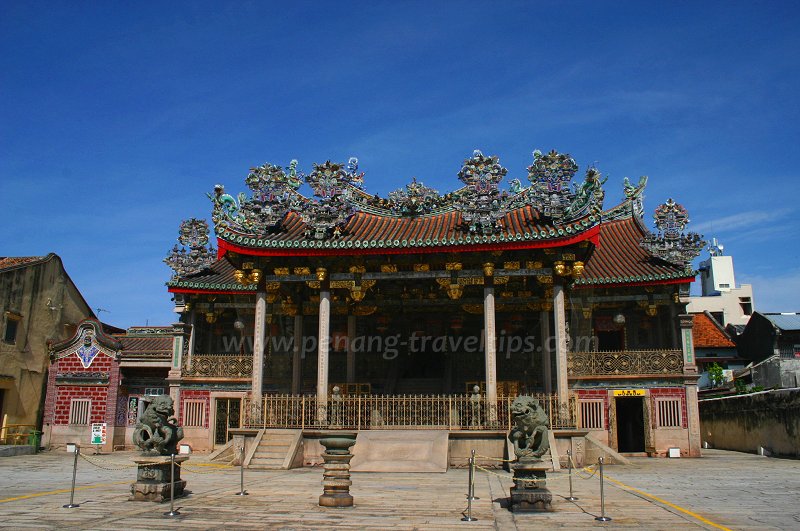 Khoo Kongsi compound (28 February 2004)
Khoo Kongsi compound (28 February 2004)
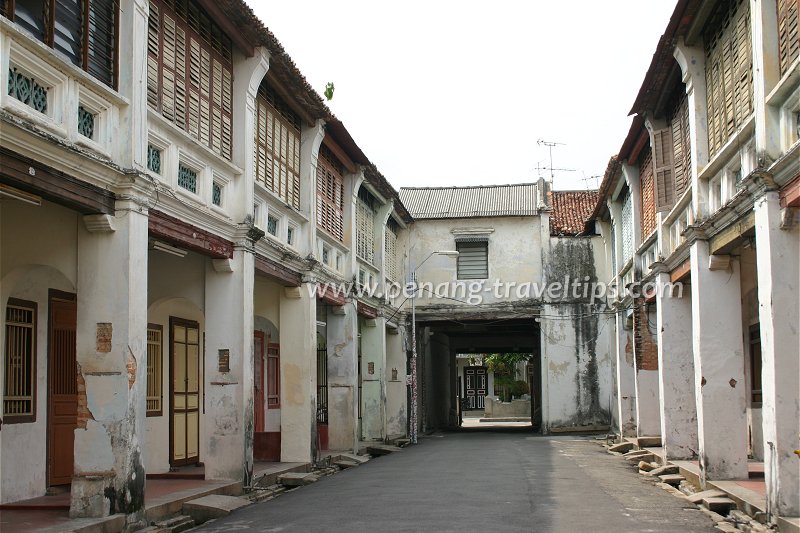 Passage into Khoo Kongsi (28 February 2004)
Passage into Khoo Kongsi (28 February 2004)
The Khoo Kongsi is in fact a miniature clan village set into the city of George Town. Many of the town houses surrounding the Khoo Kongsi clan temple bear the sign "Sin3 Kang4", as do the gateways leading into Khoo Kongsi. There were originally three access passages to the clan temple. The principal access is via Cannon Street with auxiliary passages to Beach Street and Armenian Street. Apart from the principal access, the other two are narrow alleys fronted by an ornate gate. The Khoo Kongsi Beach Street entrance is the more ornate, while the entrance at Armenian Street is quite plain. These gates can be shut in times of trouble, to prevent intruders from entering the compound.
Since a recent renovation of the temple complex, the two narrower passageways have been sealed off, leaving now only a single entrance into and out of Khoo Kongsi, and that is, the main passageway from Cannon Square.
There is also a clan museum occupying the ground floor of the temple. Visitors now have to pay an entrance fee that goes to the general upkeep of the place. These are waived on celebratory days, such as during the annual Chinese New Year Open House and the George Town Festival.
The land to built Khoo Kongsi was acquired in 1851. It measures 97,035 sq feet. Before its construction, there was a bungalow on the site, and this was converted into a clan temple for ancestor worship. This temple was named Leong3 San3 Tong3, meaning "Dragon Mountain Hall", to commemorate and honour of the Khoo progenitor's village of Leong San in China.
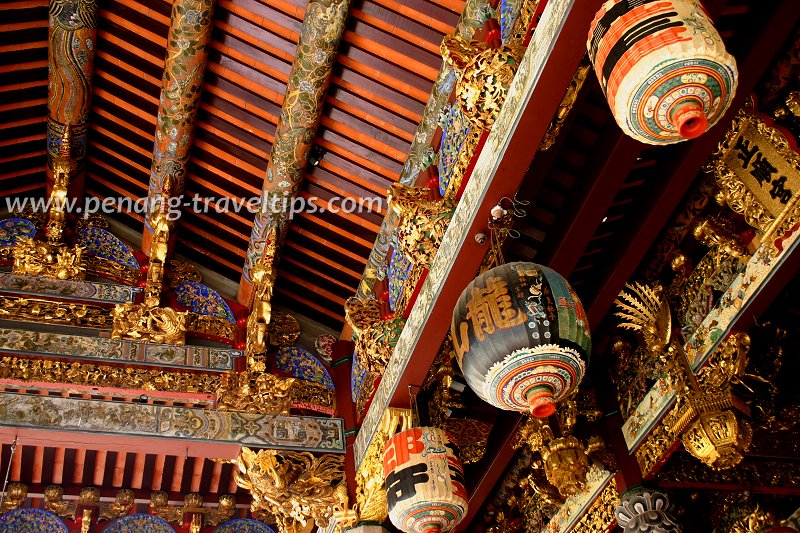 Ceiling of the outer porch of Leong San Tong Khoo Kongsi (28 February 2004)
Ceiling of the outer porch of Leong San Tong Khoo Kongsi (28 February 2004)
Over the years since the acquisition of the land in 1851, the Khoos prospered and established themselves in the upper strata of Penang society. However, as part of defending their rights against the Ghee Hin Secret Society, the Khoo clansmen under their leader Khoo Thean Teik, was involved in the Penang Riots of 1867. The Khoos fought alongside their Muslim brethren of the Red Flag Secret Society, whose leader was Syed Mohamad Al-Attas, against the Ghee Hins. In 1868, Khoo Thean Teik was arrested for his role in the fighting and was sentenced to death. However, he did not meet such a fate, but instead was released from prison after seven years.
In 1894, an idea was mooted to construct a new clan temple to replace the existing structure. It was a highly ostentatious project to showcase the Khoo's newly acquired wealth, and the grand new temple took eight years to complete. Strangely, just 29 days after its completion, on the eve of the Sin Chooi Year, a fire broke up, destroying the whole temple. The only items salvaged from the inferno was a pair of carved bamboo couplets known as "teik lean". These are still on display today in the Tua Pek Kong Hall, to the right of the main hall of Khoo Kongsi.
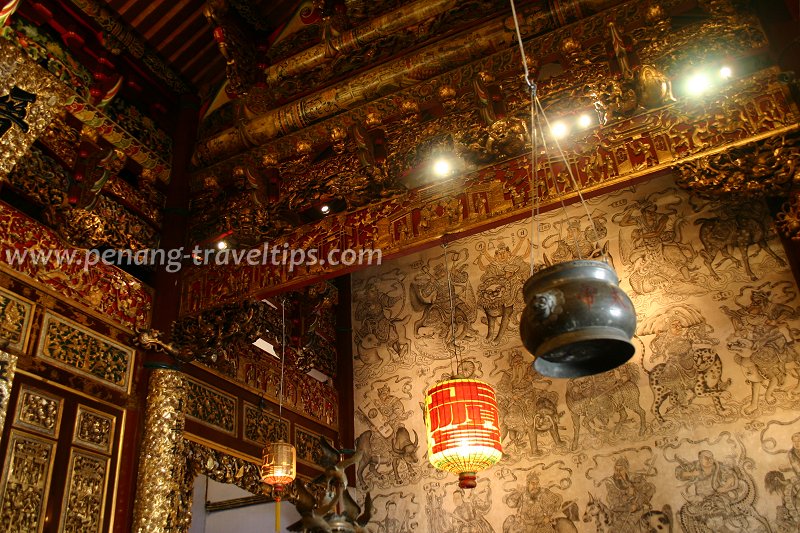 Ceiling of the Central Hall of Leong San Tong Khoo Kongsi (28 February 2004)
Ceiling of the Central Hall of Leong San Tong Khoo Kongsi (28 February 2004)
Clueless over how the fire started, the Khoos attributed it to the wrath of the gods for having erected such a lavish temple for the worship of their patron saints and ancestors, who were mere mortals. A few years after the first temple was destroyed, plans were afoot to built it again.
To avoid angering the gods, the new temple is a scaled-down version of the original. Nevertheless materials for the new temple were shipped from China, and master craftsmen, artists, artisans and sculptors were also brought in from China to complete the new temple, and when it was completed, the new Leong San Tong stood as another Khoo masterpice. It was completed in 1906, at the cost of a hundred thousand Straits dollars.
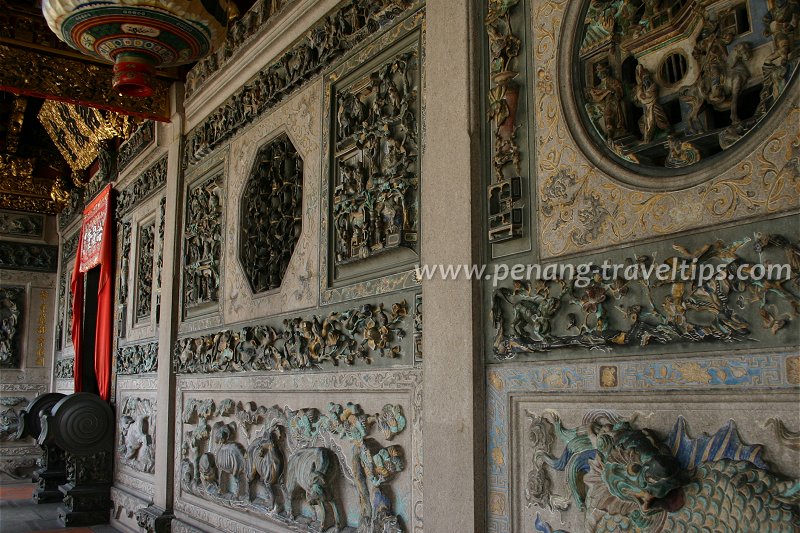 The ornate façade of Leong San Tong (28 February 2004)
The ornate façade of Leong San Tong (28 February 2004)
The Leong San Tong suffered partial damage during the Second World War when it was shelled by the Japanese. The bombing also took its toll on some 20 townhouses within the Khoo Kongsi courtyard. After the war, restoration of the structure took four years and costs sixty thousand Straits dollars.
The splendour of Khoo Kongsi lies in its highly detailed wood carvings, wall frescoes and roof decorations. The whole roof structure is said to weigh 25 to 50 tons, and is the best example of the chien1 nien2 cut-and-paste technique, where shards of ceramic bowls are used to form patterns, beasts, mortals and immortal beings.
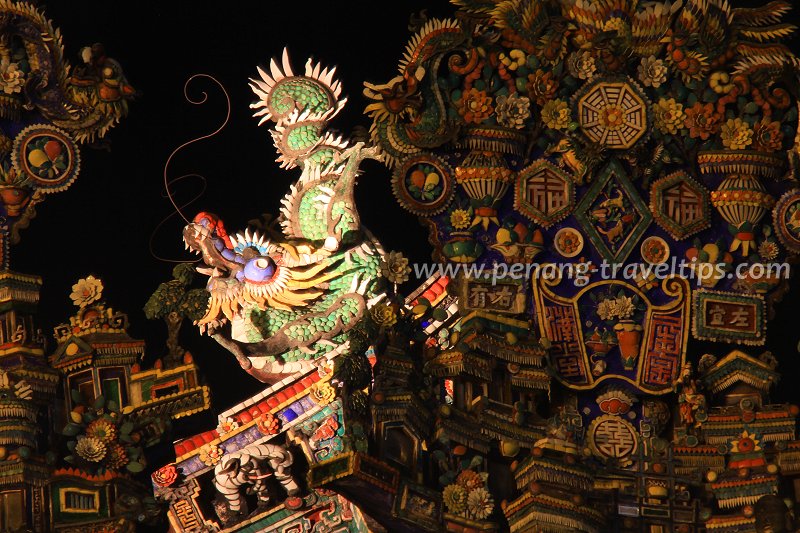 Khoo Kongsi roof ornamentation (7 July 2012)
Khoo Kongsi roof ornamentation (7 July 2012)
Layout of Leong San Tong Khoo Kongsi
The clan temple consists of two floors, the ground floor and the top floor. The ground floor was previously occupied by the Toon Boon Tong, or the Parentage Society, which was founded in 1884. Nowadays, it is used as the Khoo Kongsi Clan Museum. To the left of the museum is a small giftshop.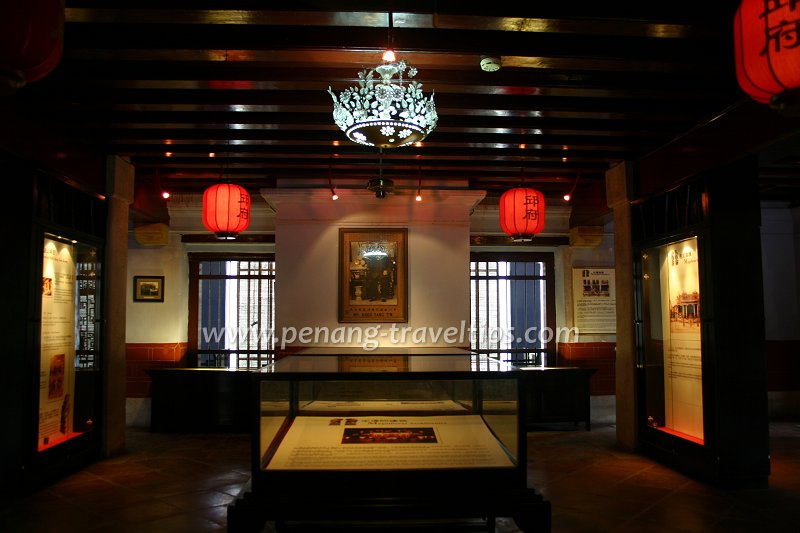 Khoo clan museum (28 February 2004)
Khoo clan museum (28 February 2004)
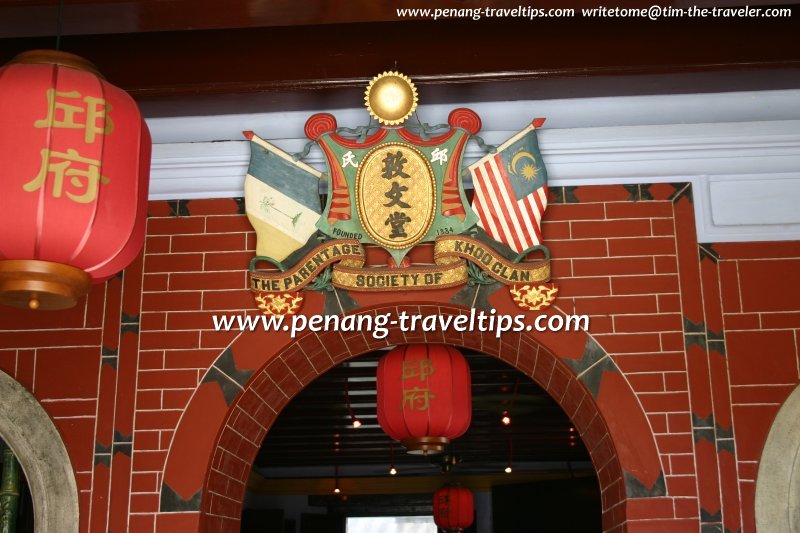 Access to the Parentage Society of Khoo Clan at Khoo Kongsi (28 February 2004)
Access to the Parentage Society of Khoo Clan at Khoo Kongsi (28 February 2004)
The top floor is accessible by the grand staircase. Flanking the staircase are the Two Monks. The one on the right is called the Crying Monk. On the other side is the Laughing Monk. Now why is the monk laughing? If you look under him, and you will find that there is a small copper coin embedded beneath the handrail. Thus this monk is laughing because he is sitting on money!
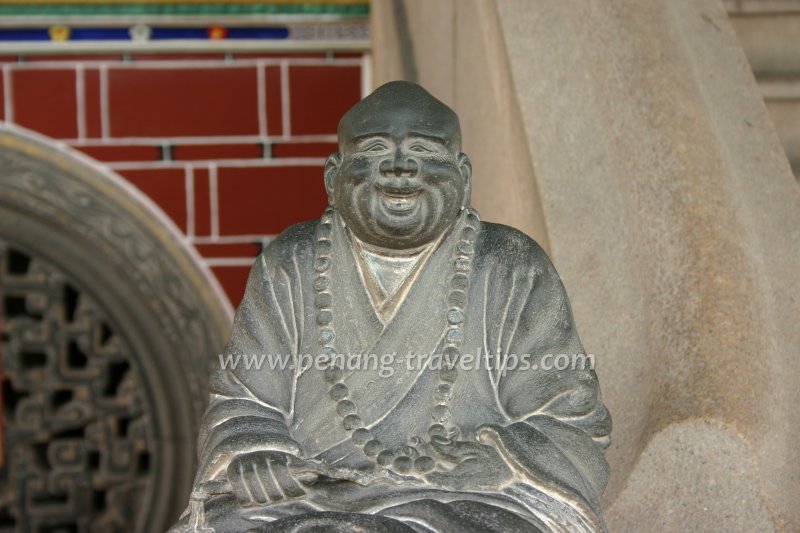 The Laughing Monk - he is happy because he is sitting on money (28 February 2004)
The Laughing Monk - he is happy because he is sitting on money (28 February 2004)
There are three main halls on the top. They are the central hall, the ancestral hall to the left, and the hall to the god of prosperity to the right.
The Central Hall is the biggest and most ornate chamber of Leong San Tong. Flanking its entrance is a pair of guardian lions with rolling marble balls in their mouths. The central hall is dedicated to the Khoo's patron saints, known by their honorific titles, Ong Soon and Tai Sai. They are deified mortals who were warriors involved in defending China against invaders from the north.
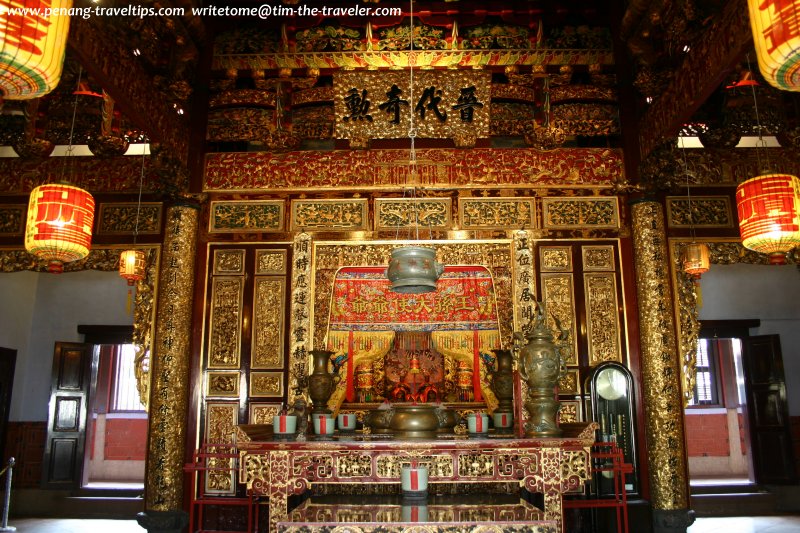 The main altar at Khoo Kongsi (28 February 2004)
The main altar at Khoo Kongsi (28 February 2004)
As you look up to the ceiling of the Central Hall, you will see lanterns and other receptacles hanging down from above. These have been in place since 1906. On the walls of the Cental Hall are ink frescoes detailing the deeds of the 36 legendary heroes and heroines of Chinese mythology. Also on display are two green marble plaques inscribed with the names of the 102 Khoo clansmen who founded the association, along with photographs of past and present Trustees of Khoo Kongsi.
To the left of the Central Hall is the Ancestral Hall. This somewhat more subdued chamber holds the ancestral tablets, or Sin3 Choo1 Pai2. These are tablets inscribed with the name of a dearly beloved member of the Khoo clan who had departed. In front of the tablets is an ornate altar table for ancestral worship. On the walls, on both sides of the Ancestral Hall are plaques congratulating various members of the Khoo clan who have gained academic excellence or have received recognition for their service to society.
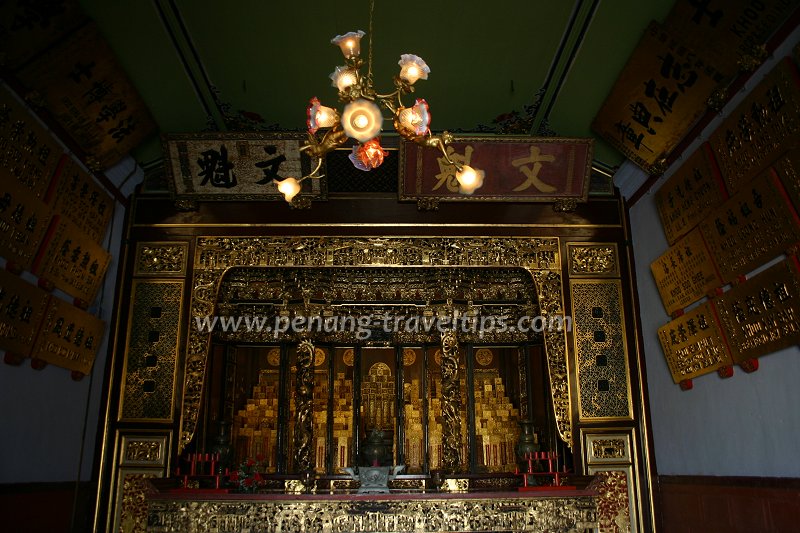 Ancestral Hall, Khoo Kongsi (28 February 2004)
Ancestral Hall, Khoo Kongsi (28 February 2004)
To the right of the Central Hall is the Tua33 Pek1 Kong1 Hall, or Hall to the God of Prosperity. There is also an altar table here, this one for the worship of the God of Prosperity. If you compare it to the one in the Ancestral Hall, you will find that it is placed slightly to the front. This is to indicate the superiority of the deity over the departed mortals. As with the Ancestral Hall, the walls of the Tua33 Pek1 Kong1 Hall is lined with congratulatory plaques.
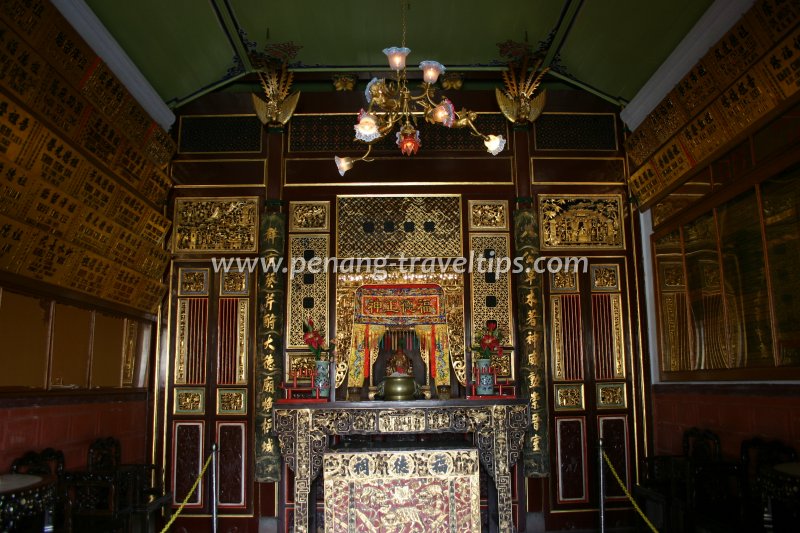 The Tua Pek Kong Hall, with its altar table (28 February 2004)
The Tua Pek Kong Hall, with its altar table (28 February 2004)
Located right across from the Leong San Tong Clan Temple is the temple stage. This is where performances are staged for the pleasure of the patron saints and departed ancestors, and also for the enjoyment of the audience.
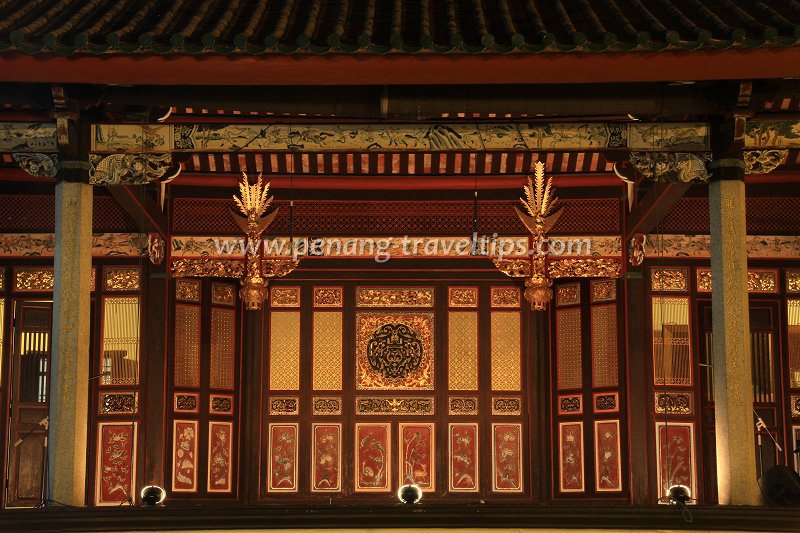 Khoo Kongsi stage (2 February 2013)
Khoo Kongsi stage (2 February 2013)
As one of the grandest buildings in George Town, the Leong San Tong Khoo Kongsi receives a steady stream of tourists every day to admire its exquisite craftsmanship, from the majestic roof ornamentations to the lavish interior designs. It stands as one of the must-see sights within the George Town World Heritage Site.
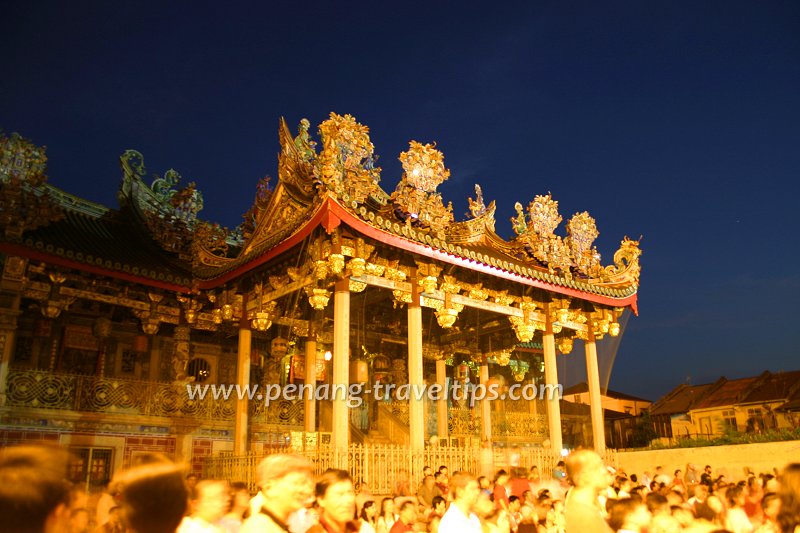 Leong San Tong Khoo Kongsi, on a festivity night (13 February 2005)
Leong San Tong Khoo Kongsi, on a festivity night (13 February 2005)
Getting there
Rather than walking, if you are coming from the Weld Quay Ferry & Bus Terminal, take Rapid Penang buses 301, 302, 401 or 502 to Kampung Kolam. From there, walk to Leong San Tong Khoo Kongsi (refer to the attached map).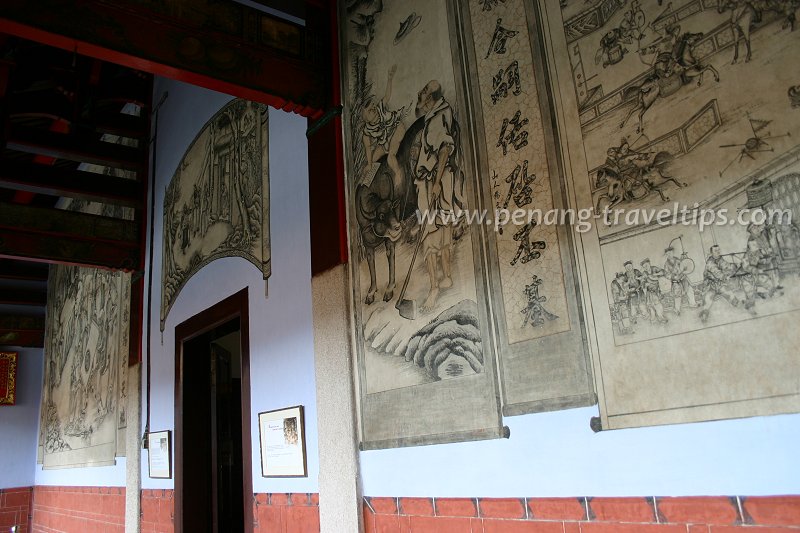 Ink murals cover the walls on the rear side of Leong San Tong Khoo Kongsi (28 February 2004)
Ink murals cover the walls on the rear side of Leong San Tong Khoo Kongsi (28 February 2004)
What to see and do there
Enter Khoo Kongsi through the main entrance at Cannon Square. After paying for your admission, go around the temple stage. The Dragon Mountain Hall, or Leong San Tong, is in front of you. Visit the clan museum at the ground floor, and then proceed upstairs to admire the exquisite prayer halls. Remember to look for the Laughing Monk. If the back portion upstairs is open to the public, go and admire the ink frescoes on the wall.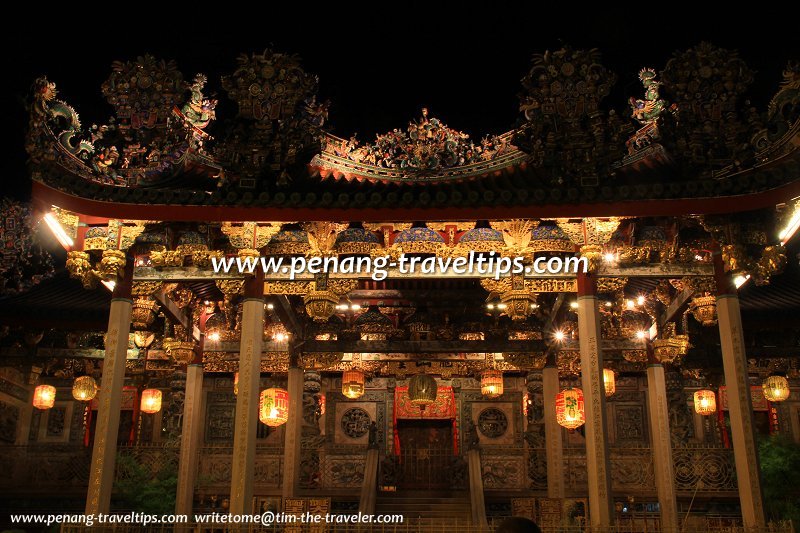 The Leong San Tong Khoo Kongsi at night (7 July 2012)
The Leong San Tong Khoo Kongsi at night (7 July 2012)
Penang Hokkien Section
This section is in Penang Hokkien and is part of Learn Penang Hokkien. It helps you practise reading in the language. Refer to the Penang Hokkien Dictionary for words that you are not sure.Leong3 San3 Tong3 Khoo1 Kong3si1
Leong3 San3 Tong3 Khoo1 Kong3si1 si33 te33-it1 tua33-keng1 kokh1 te33-it1 swee4 eh3 kong3si1-eh3 beo3 ti1 Huan3peng2. Cit1-leh1 kong3si1 si33 ang3mor2 1835 ni2 kien1lip1 eh2. Cit1-leh1 beo3 si33 1906 ni2 co3 ho4 eh2. Khoo Kongsi-eh3 beo3 si33 cit3-leh3 nor33-can1 lau2. Ti1 lau3teng4 si33 cong1su2. Ti1 cit1-peng2 snaeh1 Khoo-eh3 lang2 pai3 ie1lang2-eh3 cor1kong1. Ti1 cit1-peng2 uh33 cin3 ce33 sin3cu1pai2. Tun1 si33 uh33 ang3kong3tok3 hor33 snaeh1 Khoo-eh3 lang2 pai3 ie1lang2-eh3 ang3kong1.Tua3 ti1 beo3-eh3 lau3kha1 si33 snaeh3 Khoo-eh3 kor1tong1keng1. Ti1 cit1-peng2 lang3 tharn1 bat3 khi4 Khoo1 snaeh3-eh3 lang3-eh3 lek3su4 ti1 Pin3 Sniah2.
A33si33 boek1 jip1 khee3 Leong San Tong Khoo Kongsi, tiok3 boek1 beh1 tnua1 ti1 gua33bin33 mui2. Ti1 tua33 jit3ci3-eh3 si2 jip1 khee3 boh3 thaek3 lui1.
Translation
Leong San Tong Khoo Kongsi is the biggest and most beautiful clan temple outside China. This clan association was established in 1835. This temple was completed in 1906. The Khoo Kongsi temple is a two-storey building. On the upper floor is the ancestral hall. Over here the Khoos worship their ancestors. There are many ancestral tablets here. There are also altar tables for the Khoo to worship their deities.
On the group floor is the Khoo clan museum. Over here, people can get to know the history of the Khoo clan in Penang.
If you wish to enter Leong San Tong Khoo Kongsi, you have to pay at entrance fee at the outer gate. Entrance fees are waived on festive days.
Penang Hokkien Video Reading: Leong San Tong Khoo Kongsi
For more reading material in Penang Hokkien, go to Reading Material in Penang Hokkien. View also the Penang Hokkien Video Guides for video readings in Penang Hokkien.
Leong San Tong Khoo Kongsi on Google Street View
Leong San Tong Khoo Kongsi, Penang (Aug 2014)References
- Leong San Tong Khoo Kongsi, the Heritage Jewel of Penang
List of Clan Temples in Penang, Chinese Temples in Penang and Chinese Temples in Malaysia
 Buy, rent or sell properties in Penang
Buy, rent or sell properties in Penang
Do you have a property for sale or to rent out? Are you looking to buy or rent a property? Get in touch with me. WhatsApp me (Timothy Tye) at 012 429 9844, and I will assign one of my property agents to serve you. I will choose the agent for you, according to your property needs. So when you message me, provide me some details of what you need, whether to sell, to buy, to rent or to rent out, and what type of property, is it condo, apartment, house, shop, office or land.Adakah anda mempunyai hartanah untuk dijual atau disewakan? Adakah anda ingin membeli atau menyewa hartanah? Hubungi saya. WhatsApp saya (Timothy Tye) di 012 429 9844, dan saya akan menugaskan salah seorang ejen hartanah saya untuk berkhidmat kepada anda. Saya akan pilih ejen untuk anda, mengikut keperluan hartanah anda. Oleh itu, apabila anda menghantar mesej kepada saya, berikan saya beberapa butiran tentang apa yang anda perlukan, sama ada untuk menjual, untuk membeli, untuk disewakan atau untuk disewakan, dan jenis hartanah apakah itu kondo, pangsapuri, rumah, kedai, pejabat atau tanah.
您有待出售或出租的房产吗? 您想购买或租赁房产吗? 与我联系。 WhatsApp 我 (Timothy Tye) 012 429 9844,我将指派一名房地产经纪人为您服务。 我会根据您的房产需求,为您选择代理。 因此,当您给我发消息时,请向我提供一些您需要的详细信息,无论是出售、购买、出租还是出租,以及房产类型,是公寓、公寓、房屋、商店、办公室还是土地。
 New Properties in Penang
New Properties in Penang
Looking to buy property in Penang? Get the e-brochures right here without having to visit or contact individual developers.- Anggun Residences E-Brochure, Batu Kawan
- Aston Acacia E-Brochure, Bukit Mertajam
- Beacon Executive Suites E-Brochure, George Town
- Beverly Heights @ Bukit Gambir E-Brochure, Gelugor
- BM Highland E-Brochure, Bukit Mertajam
- Cypress Villa E-Brochure, Sungai Ara
- D'Zone Condominium E-Brochure, Teluk Kumbar
- Elements Garden E-Brochure, Butterworth
- Ferringhi Residence 2 E-Brochure, Batu Ferringhi
- GEM Residences E-Brochure, Prai
- Golden Triangle 2 E-Brochure, Sungai Ara/Relau
- Grace Residence E-Brochure, Jelutong
- Granito @ Permai E-Brochure, Tanjong Bungah
- Green City Residence E-Brochure, Jelutong
- Havana Beach Residences E-Brochure, Bayan Lepas
- Imperial Residences E-Brochure, Sungai Ara/Relau
- Imperial Grande E-Brochure, Sungai Ara/Relau
- Lucerne Residence E-Brochure, Bayan Lepas
- Mezzo @ The Light City E-Brochure, Gelugor
- Middleton E-Brochure, Gelugor
- Orchard Villa 3 E-Brochure, Simpang Ampat
- Primero Heights E-Brochure, Permatang Pauh
- Queens Waterfront Q2 E-Brochure, Bayan Lepas
- Royale Heights @ Tambun Royale City E-Brochure, Simpang Ampat
- Royale Infinity @ Tambun Royale City E-Brochure, Simpang Ampat
- Rubica @ Harbour Place E-Brochure, Butterworth
- Sensasi Commercial Suites E-Brochure, Batu Kawan
- Setia Sky Ville E-Brochure, Jelutong
- Setia Sky Vista E-Brochure, Sungai Ara/Relau
- Setia V Residence E-Brochure, Gurney Drive
- Sinaran Residence E-Brochure, Batu Kawan
- Sky @ TriPark E-Brochure, Bukit Mertajam
- Skyridge Garden E-Brochure, Tanjong Tokong
- Starhill Luxury Residences E-Brochure, Gelugor
- Straits Residences E-Brochure, Tanjong Tokong
- Taman Nuri Emas E-Brochure, Nibong Tebal
- The Light Collection IV E-Brochure, Gelugor
- The Loft @ Southbay E-Brochure, Batu Maung
- The Terraces Condominium E-Brochure, Bukit Jambul
- Trehaus Condo Villas E-Brochure, Bukit Jambul
- Triuni Residences E-Brochure, Batu Uban
- Urban Suites E-Brochure, Tanjong Tokong
- Valencia Residence E-Brochure, Bayan Lepas
- Vertu Resort E-Brochure, Batu Kawan
- Vivo Executive Apartment E-Brochure, Batu Kawan
- Viluxe E-Brochure, Batu Kawan
- Waterside Residence E-Brochure, Gelugor
 Latest updates on Penang Travel Tips
Latest updates on Penang Travel Tips
 Discover with Timothy YouTube Channel
Discover with Timothy YouTube Channel
 PG Food Channel
PG Food Channel
 Learn Penang Hokkien YouTube Channel
Learn Penang Hokkien YouTube Channel
 SojiMart Videos
SojiMart Videos
 Share your travels and/or ask a travel-related question
Share your travels and/or ask a travel-related question
Join the Penang Travel Tips Facebook Group to share photos, tips and anything related to your travels, or ask travel-related questions.
 Map of Roads in Penang
Map of Roads in Penang
Looking for information on Penang? Use this Map of Roads in Penang to zoom in on information about Penang, brought to you road by road. Discover with Timothy
Discover with Timothy
Let me take you to explore and discover Penang through my series of walking tours on YouTube. You may use these videos as your virtual tour guide. At the beginning of each video, I provide the starting point coordinates which you may key into your GPS, Google Maps or Waze, to be navigated to where I start the walk, and use the video as your virtual tour guide.Disclaimer
Please use the information on this page as guidance only. The author endeavours to update the information on this page from time to time, but regrets any inaccuracies if there be any.Latest from Discover with Timothy: Gurney Bay - what to see and do there
About this website

Hello and thanks for reading this page. My name is Timothy and my hobby is in describing places so that I can share the information with the general public. My website has become the go to site for a lot of people including students, teachers, journalists, etc. whenever they seek information on places, particularly those in Malaysia and Singapore. I have been doing this since 5 January 2003, for over twenty years already. You can read about me at Discover Timothy. By now I have compiled information on thousands of places, mostly in Peninsular Malaysia and Singapore, and I continue to add more almost every day. My goal is to describe every street in every town in Malaysia and Singapore.
Robbie's Roadmap
- Episode 1: Robbie's Journey to Financial Freedom
- Episode 2: Lost in America
- Episode 3: The Value of Money
- Episode 4: The Mentor
- Episode 5: The Thing that Makes Money
- Episode 6: The walk with a Billionaire
- Episode 7: The Financial Freedom Awakening
- Episode 8: Meet Mr Washington
- Episode 9: The Pizzeria Incident
Copyright © 2003-2024 Timothy Tye. All Rights Reserved.